-
Discover new ways to elevate your game with the updated DGCourseReview app!
It's entirely free and enhanced with features shaped by user feedback to ensure your best experience on the course. (App Store or Google Play)
You are using an out of date browser. It may not display this or other websites correctly.
You should upgrade or use an alternative browser.
You should upgrade or use an alternative browser.
Drive Leg Mechanics
- Thread starter sidewinder22
- Start date
Brychanus
* Ace Member *
Would ya'll quit being smart and stuff.
My brain hurts a bit reading that.
Butt back make easy butt wipe - good.
Butt down make hard butt wipe - bad.
Wanted to add a little posture nugget that keeps popping up in my form. I think I finally started to clean up this week accidentally while I was struggling with footwork tweaks. It is helping me understand how to set up clean & easy drive leg mechanics & the transition into the plant. I keep seeing it across form reviews. It has been said before but hopefully the association to other ideas in the drive leg & plant stride is helpful to some.
In hindsight, I wish I'd gotten the point of this very basic posture contrast better drilled into my body now that I understand just how deeply it facilitates everything that follows.
In this very short vid, you can learn how to get into a "posterior chain" (sitting-like) loading and contrast it with "anterior chain" (squat-like) loading.

The posterior loading posture sets up your hip hinges and ability to freely tilt into the backswing and downswing - it's all built into the same posture. The contrast is what I'm focused on here- switch back and forth several times between the anterior and posterior load to teach the body the difference:
If you settle into that posture and just start "freewheeling" around in motion, doing Battering Rams, duck walking, trying the triangle drill, driving into the plant, swinging a disc over the plant leg etc., you can start to feel the connection between all the components of the swing. If you don't have the connection yet, you can keep returning to this basic posture and test out new moves - always starting from this posture reinforces the correct loading.
If you are correctly in a posterior loaded posture, it's much easier to achieve that "bouncy" feeling between the feet when standing or striding. I also found that it's drastically easier to "spring" into the plant stride from a posterior-loaded "sweet spot". If you're too anterior, the bounciness, springiness, and the rear leg counterbalance are at least partially prohibited, and you will see more "spinning out" of the drive and plant legs.
So if you struggle with this, I suggest practicing the contrast between the anterior and posterior loading as in the quick vid above to give your body/brain clear feedback. Then, set up in a posterior posture, and as you load that drive leg in a backswing, you should feel easier compression and a more natural rock back, and easier transition forward. It's possible to go too far, so you might need to fuss a little at first. The clear contrast to the fully anterior load "squat-like" load helps.
Just today, I realized that part of the problem with my own footwork was because my body didn't really ever fully encode the fundamental difference between an anterior and posterior loading, and I kind of ended up on some fine line between the two in most of my practice and real swings. So my legs were never consistently set up for success to begin with and were constantly confused even as other stuff has gotten much better, drifting between more anterior and posterior loading from swing to swing.
Of course, SW22 and others have pointed all this out before, but sometimes I have to bump back into it all over again later to get the point. I also wonder how much it really would have mattered earlier in my own development, but given the prevalence of "anterior/split loaders" out there, hopefully this inspires some to try it out and reinforce that clear brain/body feedback. :hfive:
Doing the drill above and then going back to SW22's Power of Posture might cause some lightbulb moments:
This is fully a lightbulb moment for me, and the movement exercise to distinguish each type is pure gold. I've been thinking about my posture issue for a while but couldn't break down what I needed to change. Three throws in a field after trying this and there's clear improvement. First throw getting comfortable in the posture, second throw aligning better behind the plant leg (tilted spiral esque) and third throw pushing my belt buckle out at the target in the follow through led to some of the most aesthetically pleasing slow motion footage I've taken of myself. No more tipping over the plant leg!
Brychanus
* Ace Member *
This is fully a lightbulb moment for me, and the movement exercise to distinguish each type is pure gold. I've been thinking about my posture issue for a while but couldn't break down what I needed to change. Three throws in a field after trying this and there's clear improvement. First throw getting comfortable in the posture, second throw aligning better behind the plant leg (tilted spiral esque) and third throw pushing my belt buckle out at the target in the follow through led to some of the most aesthetically pleasing slow motion footage I've taken of myself. No more tipping over the plant leg!
Great!
Each tweak comes with new tradeoffs so it's worth mentioning them. E.g., just this week I got back to the field and I was comfortably more "posterior" and my chain felt pretty fluid, but then I got a "rising shoulder" again and couldn't quite tell why. SW22 pointed out that I also started planting with my weight too far into my heel, and my swim move starting to come in too early & behind my front leg. So basically you want the muscle load to be posterior, but you still need to come into the plant at a correct angle from that posture - don't let the weight land too "posterior" in the plant, in other words. Kinda tricky if you're new to it.
I found it much more natural to get the action in skaters/duck walks and then speeding up to strafe sideways like a defender in basketball or linebacker. It'll take practice to get it working better at speed in the DG BH.
In practice swings I'm finding it helpful to settle into the right "posterior" posture, then focus on landing in a firmer lateral plant & a patient and more forward swim move.
Regarding getting good plant action from a "posterior" load, you can see the first two gifs SW22 linked in this thread for "strafing" exercises. It might be helpful to isolate the "pure" lateral component with little shuffle exercises:

You can also add some hops and plyometric jumps on either end, which gets you more comfortable with vertical force.
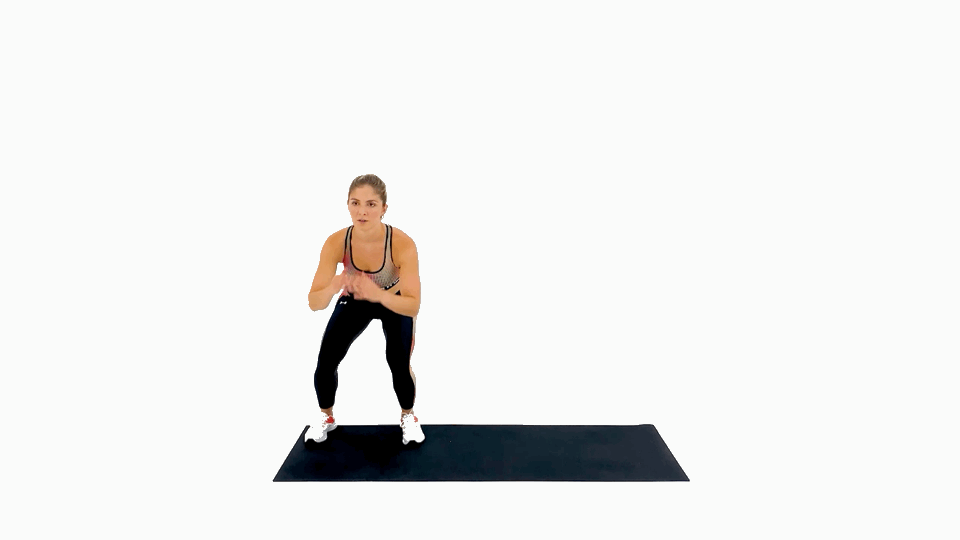
When she lands from the jump at either end, notice that she resists letting her butt go too low - she's going right back into the "posterior" loading and resisting the ground the same way you want to when you land in the plant.
The DG transition from drive step to the plant is the same action and more horizontal or vertical depending on the throw style. Look at the the foot/leg actions above and notice that they are the same as Paige here - she has a posterior load, but from the BH posture including the buttwipe transitioning from the drive leg and landing into the plant:
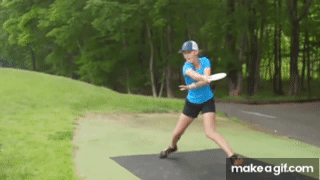
Last edited:
Sheep
Sir, This is a Wendy's
- Joined
- Jul 27, 2017
- Messages
- 1,370
I started to make a video on this particular topic a few years ago and didn't like how it turned out.
This overall motion and exercise is something we did when I wrestled. It made me unstoppable in basketball. And gave me a massive advantage in baseball. I could move laterally faster than other ball players could possibly try to move around me because we practiced it so much. In baseball, my ability to laterally move into the run made hitting bases easy. I didn't have to turn and then run.
But what people see is pro's running super super fast at the tee pad from 10 to 30 feet (thanks conrad) and then trying to trip over themselves with bad x-steps and other things, and they are never even looking at loading properly this way.
So their cross step is bad, and other things.
I have no idea where i'm going with this anymore, but.
Proper lateral drills will teach you to x-step properly, because you have to cross correctly if you want to move correctly.
Brychanus
* Ace Member *
I started to make a video on this particular topic a few years ago and didn't like how it turned out.
This overall motion and exercise is something we did when I wrestled. It made me unstoppable in basketball. And gave me a massive advantage in baseball. I could move laterally faster than other ball players could possibly try to move around me because we practiced it so much. In baseball, my ability to laterally move into the run made hitting bases easy. I didn't have to turn and then run.
But what people see is pro's running super super fast at the tee pad from 10 to 30 feet (thanks conrad) and then trying to trip over themselves with bad x-steps and other things, and they are never even looking at loading properly this way.
So their cross step is bad, and other things.
I have no idea where i'm going with this anymore, but.
Proper lateral drills will teach you to x-step properly, because you have to cross correctly if you want to move correctly.
SocraDeez and I are getting into the whole posterior/anterior load in transition discussion in my Form thread. We're still toying with that, but I think however that turns out to work, practical "athletic" drills like this are really important esp. for people like me who have limited sports experience to draw from.
Strafing into the plant like a linebacker gets your body moving very differently overall. I didn't realize how aggressive the move into the plant was until I starting doing moves like that exercise/drill. I also didn't realize that as long as you're maintaining balance and in better posture it's not too hard on the body.
Sheep
Sir, This is a Wendy's
- Joined
- Jul 27, 2017
- Messages
- 1,370
SocraDeez and I are getting into the whole posterior/anterior load in transition discussion in my Form thread. We're still toying with that, but I think however that turns out to work, practical "athletic" drills like this are really important esp. for people like me who have limited sports experience to draw from.
Strafing into the plant like a linebacker gets your body moving very differently overall. I didn't realize how aggressive the move into the plant was until I starting doing moves like that exercise/drill. I also didn't realize that as long as you're maintaining balance and in better posture it's not too hard on the body.
It's one of the reasons I don't think huge runups are necessary most of the time also.
If you're driving into your plant properly, you should, by random brain power, be getting 80% of your total power potential.
Looking at guys like GG and DG with their power, they are driving hard with legs like this vs running and basically stopping a forward falling unbalance as I look at it.
Brychanus
* Ace Member *
It's one of the reasons I don't think huge runups are necessary most of the time also.
If you're driving into your plant properly, you should, by random brain power, be getting 80% of your total power potential.
Looking at guys like GG and DG with their power, they are driving hard with legs like this vs running and basically stopping a forward falling unbalance as I look at it.
You'll see GG, DG, Eagle, etc. add longer runups for their biggest drives, but I agree that the fact those guys are still mashing over 500' with minimal runups/short x-step/linebacker strafe mostly speaks for itself (leverage/youth/athletic advantages aside).
I like thinking about achieving and maintaining "dynamic balance" like walking rather than aiming to achieve "unbalance." Such as the relationship between the swing & Olympic hammer toss here. and "riding the bull" here. That concept makes contact with motion kinetics in other contexts.
Main difference between pitching and BH is that pitchers open up the front side into longer stride/stance coming into the plant to get the lead side out of the way to swing the frontside of trailing arm/shoulder, while in disc golf BH we have to stay closed on the front side into the plant with shorter stride/stance to swing the backside of the lead arm/shoulder.
Overhand pitching stride = roller or anhyzer.
Submarine pitching stride = hyzer or flat.
I can see it:
Brychanus
* Ace Member *
I wanted to recap some deep learning that is ongoing.
Shout out to SocraDeez for challenging me on a couple fundamental misunderstandings about the drive leg (and the problem with calling it that) I had that were really hampering my development. This easily cross-reference to "rocking the hips" in various ways, and part of the point is that the drive leg and rocking the hips are inseparable. It is also a big part of why some people throw much, much farther than the rest of us.
As a guy with no little athletic background, DG legs have confused the hell out of me. The plant leg is hard enough - figuring out how to plant and "resist collapse" and swing on it correctly safely clearly gives tons of people a hard time. I'm grateful just to be developing a powerful one leg throw at this point.
But if I thought that was hard, I've become convinced that the drive leg is next level. And it's not just because of the leg itself, but the context it's working in and what it's supposed to be doing - what functions does it serve? In my experience it is the thing that gets exceptionally harder when you x-step, and plenty of folks on the form threads here and elsewhere have big problems with it, including young, athletic people who are throwing pretty far (often low-mid 400s). And part of that is because they don't understand one or more aspects of how it works, and it's not just about the anatomy.
People skip the standstill phase to their peril. You can get part of a drive leg right, but if part of it is wrong it dramatically limits the consistency and potential power benefits from the x-step. Just getting a Hershyzer drift and leverage and buttwipe is hard. It's why I haven't even bothered to work on more than a 2-step walk up until recently and I now always start every practice session on one leg and standstills. But building that efficient x-step is desirable and can be a beast.
Early in our back-and-forth, SocraDeez challenged me to look at Jan Zelezny's javelin throw. Zelezny set the men's world record in 1996, which still stands to this day. Compare Zelezny's form (top) to Liu Shiying (bottom), an outstanding Gold-medal winner in her own right:
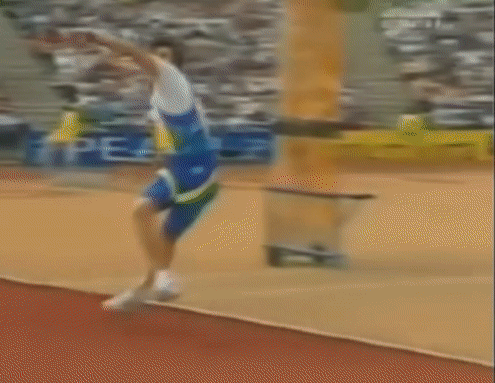
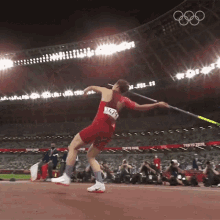
What's different between these throwers' drive legs? Both of them certainly drop into their plant to lead the throw. But notice that Zelezny's foot is in contact with the ground only long enough to load his backswing and keep him in balance. Shiying appears to have a bit more of a lag off her drive foot, and appears to have a push rather than that abrupt, clean shift Zelezny gets. If we insist on calling it a "drive" leg, we need to understand that it's something very different from a push, and very different from many other meanings of what a leg could do to "drive" you into the plant.
There was chatter recently about Ricky's 500' form and how effortless it appears. We appreciate the lateral shift:
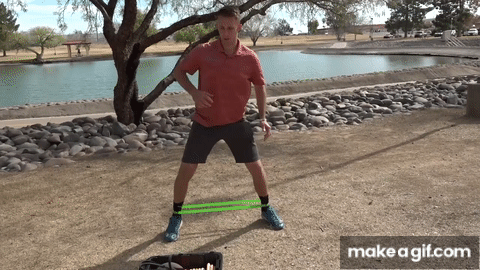
But one component of his form that people often botch in their x-step is Ricky's or other pros' impeccable Zelezny-like action, and what it implies about posture and drift and the true purpose of the drive leg. It is what you want to get whether you're a horizontal or vertical person.
This seems like a straightforward lateral stride, right?

But what about this?
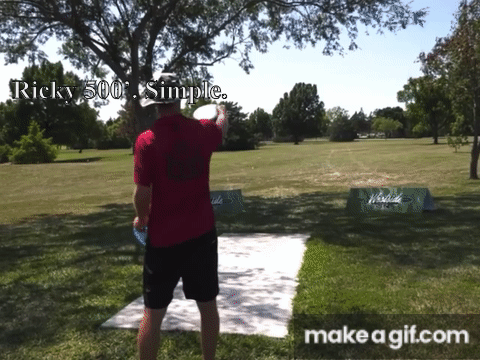
The drive leg isn't just about the drift and the drop into the plant. It is about backswing loading and dynamic posture and balance, and it is a major component about what separates the big guns from the rest of us. But that's not all.
Look at Zelezny again. What do Wysocki and Zelezny have in common in their distance drives?

This is what Buzz Lightyear called "falling in style."
Extend your notion of the drive step to well before the drive leg is even moving to leave the ground. You are in a controlled freefall.
I'm still working on the mechanics, but part of what Ricky does with those long raptor legs is get massive athletic leverage in just the right amount to help him fall, drift, and drop in the drive phase. Notice how his long, long legs involve a knee turning back away in transition before it swings back forward. This is the lateral stride - but most of us don't do it well or at all because we aren't getting enough of the rest of the swing working. We see pushing drive legs, or poor rear-side rocks, or femurs shoving into the rear hip like pistons rather than levers, and so on. If it's a pogo, you need to be very careful what kind of pogo you're getting.
But it is this controlled fall in style that begins long before the stride contacts the ground that matters and the nature of that stride that gatekeeps big power.
Here are some of the things I realized when SocraDeez was pushing me down this path.
"Part of what makes (understanding the drive leg process) hard is related to how we talk about the drift and when that process begins, and what the drive leg's role is in that context and the rest of the form. Sure, it's facilitating momentum forward and a drop or fall. It's leveraging the ground in that process and providing a fulcrum for a backswing. It's releasing a form of tension against the ground in transition. It's getting itself in a position to load and unload, countering the other leg and body. It's helping the front leg get into position in the preceding strides or the plant stride that follows. It's dynamically positioning the entire body in the context of those things, and those things only work and make sense in that context."
The drive leg problem is worth spending the time to figure out. Despite all my words, "Just Do It" comes to mind, if it were only so easy.
Shout out to SocraDeez for challenging me on a couple fundamental misunderstandings about the drive leg (and the problem with calling it that) I had that were really hampering my development. This easily cross-reference to "rocking the hips" in various ways, and part of the point is that the drive leg and rocking the hips are inseparable. It is also a big part of why some people throw much, much farther than the rest of us.
As a guy with no little athletic background, DG legs have confused the hell out of me. The plant leg is hard enough - figuring out how to plant and "resist collapse" and swing on it correctly safely clearly gives tons of people a hard time. I'm grateful just to be developing a powerful one leg throw at this point.
But if I thought that was hard, I've become convinced that the drive leg is next level. And it's not just because of the leg itself, but the context it's working in and what it's supposed to be doing - what functions does it serve? In my experience it is the thing that gets exceptionally harder when you x-step, and plenty of folks on the form threads here and elsewhere have big problems with it, including young, athletic people who are throwing pretty far (often low-mid 400s). And part of that is because they don't understand one or more aspects of how it works, and it's not just about the anatomy.
People skip the standstill phase to their peril. You can get part of a drive leg right, but if part of it is wrong it dramatically limits the consistency and potential power benefits from the x-step. Just getting a Hershyzer drift and leverage and buttwipe is hard. It's why I haven't even bothered to work on more than a 2-step walk up until recently and I now always start every practice session on one leg and standstills. But building that efficient x-step is desirable and can be a beast.
Early in our back-and-forth, SocraDeez challenged me to look at Jan Zelezny's javelin throw. Zelezny set the men's world record in 1996, which still stands to this day. Compare Zelezny's form (top) to Liu Shiying (bottom), an outstanding Gold-medal winner in her own right:


What's different between these throwers' drive legs? Both of them certainly drop into their plant to lead the throw. But notice that Zelezny's foot is in contact with the ground only long enough to load his backswing and keep him in balance. Shiying appears to have a bit more of a lag off her drive foot, and appears to have a push rather than that abrupt, clean shift Zelezny gets. If we insist on calling it a "drive" leg, we need to understand that it's something very different from a push, and very different from many other meanings of what a leg could do to "drive" you into the plant.
There was chatter recently about Ricky's 500' form and how effortless it appears. We appreciate the lateral shift:

But one component of his form that people often botch in their x-step is Ricky's or other pros' impeccable Zelezny-like action, and what it implies about posture and drift and the true purpose of the drive leg. It is what you want to get whether you're a horizontal or vertical person.
This seems like a straightforward lateral stride, right?

But what about this?

The drive leg isn't just about the drift and the drop into the plant. It is about backswing loading and dynamic posture and balance, and it is a major component about what separates the big guns from the rest of us. But that's not all.
Look at Zelezny again. What do Wysocki and Zelezny have in common in their distance drives?

This is what Buzz Lightyear called "falling in style."
Extend your notion of the drive step to well before the drive leg is even moving to leave the ground. You are in a controlled freefall.
I'm still working on the mechanics, but part of what Ricky does with those long raptor legs is get massive athletic leverage in just the right amount to help him fall, drift, and drop in the drive phase. Notice how his long, long legs involve a knee turning back away in transition before it swings back forward. This is the lateral stride - but most of us don't do it well or at all because we aren't getting enough of the rest of the swing working. We see pushing drive legs, or poor rear-side rocks, or femurs shoving into the rear hip like pistons rather than levers, and so on. If it's a pogo, you need to be very careful what kind of pogo you're getting.
But it is this controlled fall in style that begins long before the stride contacts the ground that matters and the nature of that stride that gatekeeps big power.
Here are some of the things I realized when SocraDeez was pushing me down this path.
"Part of what makes (understanding the drive leg process) hard is related to how we talk about the drift and when that process begins, and what the drive leg's role is in that context and the rest of the form. Sure, it's facilitating momentum forward and a drop or fall. It's leveraging the ground in that process and providing a fulcrum for a backswing. It's releasing a form of tension against the ground in transition. It's getting itself in a position to load and unload, countering the other leg and body. It's helping the front leg get into position in the preceding strides or the plant stride that follows. It's dynamically positioning the entire body in the context of those things, and those things only work and make sense in that context."
The drive leg problem is worth spending the time to figure out. Despite all my words, "Just Do It" comes to mind, if it were only so easy.
Last edited:
Sheep
Sir, This is a Wendy's
- Joined
- Jul 27, 2017
- Messages
- 1,370
But one component of his form that people often botch in their x-step is Ricky's or other pros' impeccable Zelezny-like action, and what it implies about posture and drift and the true purpose of the drive leg. It is what you want to get whether you're a horizontal or vertical person.

The drive leg isn't just about the drift and the drop into the plant. It is about backswing loading and dynamic posture and balance, and it is a major component about what separates the big guns from the rest of us. But that's not all.
I saw something here that I never saw before thanks to your post here. And it really makes me think about something a lot different.
Must put more time/effort into thinking about it, but I think this is an important path.
I think it comes down to an interesting level of "doesnt' seem right, but when you finally force yourself to do it, it is right and your body knows its right, but you must actually DO it properly first before your body will cooperate"
Some of those weird things. Cause I think a lot of what our systems come into is this notion that we are "throwing" something. When we need to be doing a lot of mechanical advantage quing to get our bodies into the proper process vs trying to let our dumb brain control our body. We gotta let smart brain show dumb brain how to do it.
(Thought through process vs auto process)

Extend your notion of the drive step to well before the drive leg is even moving to leave the ground. You are in a controlled freefall.
I'm still working on the mechanics, but part of what Ricky does with those long raptor legs is get massive athletic leverage in just the right amount to help him fall, drift, and drop in the drive phase. Notice how his long, long legs involve a knee turning back away in transition before it swings back forward. This is the lateral stride - but most of us don't do it well or at all because we aren't getting enough of the rest of the swing working. We see pushing drive legs, or poor rear-side rocks, or femurs shoving into the rear hip like pistons rather than levers, and so on. If it's a pogo, you need to be very careful what kind of pogo you're getting.
But it is this controlled fall in style that begins long before the stride contacts the ground that matters and the nature of that stride that gatekeeps big power.
Here are some of the things I realized when SocraDeez was pushing me down this path.
"Part of what makes (understanding the drive leg process) hard is related to how we talk about the drift and when that process begins, and what the drive leg's role is in that context and the rest of the form. Sure, it's facilitating momentum forward and a drop or fall. It's leveraging the ground in that process and providing a fulcrum for a backswing. It's releasing a form of tension against the ground in transition. It's getting itself in a position to load and unload, countering the other leg and body. It's helping the front leg get into position in the preceding strides or the plant stride that follows. It's dynamically positioning the entire body in the context of those things, and those things only work and make sense in that context."
The drive leg problem is worth spending the time to figure out. Despite all my words, "Just Do It" comes to mind, if it were only so easy.
My knee hurts so much watching this.
And somehow going through and re-reading this. I for some reason was picking through all this info differently. I was for some reason really focused on his plant/drift timing, not the drive leg.
But, Ricky's X-Step.
That's like textbook perfect.
Nice and tight allowing for really good hard drive into the shot, where he's not looking for his momentum to carry him into the shot, he's setting himself up to power it as hard as he wants to. or put as much control into it as he wants to.
Brychanus
* Ace Member *
Just wanted to return to athleticism in the swing and a couple other things about what should ideally happen before the drive foot hits the ground after Sheep mentioned something to me about timing. Also wanted to share a point about individual differences.
It's no secret that I share the same kind of "timing is an effect of good mechanics, rhythm, and dynamic balance" perspective SW and some others have, so that's how I understand the following.
Here's a rear view of Ricky's backswing way back in 2012 (first slo mo throw):
Compare with Zelezny's full run-up:

(1) Notice that Wysocki and Zelezny are both launching (and using a micro-pump through the upper body if you really look for it) heading off their leg in the 3rd-to-last step.
(2) In the 2nd-to-last step or "drive stride", that rear view on Wysocki also helps you see the Zelezny-like action loading up the backswing on the rear side. Wysocki's backswing is still in sync with his rear leg like a pendulum. But Wysocki is so damn athletic and balanced and vertical moving fast over the rear leg that it can look like different timing. That rear view also really shows that in the backswing, Wysocki generates a massive pendulum, and he also has a massive horizontal and vertical force coming into the plant due to his Zelezny-like launch in the 3rd-to-last step.
I had a couple practical takeaways (shocking!).
Dutifully slow down and learn on one foot, then two feet - the x-step and this launch move over the x-step are an additional hard problem
Some of you learn or learned this stuff much faster than me. But I cannot count the number of times I've saved myself from quitting just by marching back through this throw sequence every time I make a form change in practice.
Even when I can make relatively fast adjustments in standstills, the x-step with the correct launch and landing is just a different animal. The ability to launch into a good x-step requires (1) excellent standstill mechanics and (2) lots of practice with that new dynamic problem when the feet are leaving the ground. And transitioning through that launch move correctly is not easy. Slowing down to work on just a clean 2-step (which as you can see is really a launch off front leg, hop through/over the x-step with tension against that rear leg, & a drift/drop into plant) is hard, and I'm still learning that I need to repair things in standstills first. Starting more vertical at first in the drive transition usually helps me and most other players.
Form models - takeaway concepts & individual differences
As we often discuss, form models can be important, and a one-size-fits-all approach is bankrupt - you should look around and adapt what works and reject what doesn't.
I simply cannot move the way Wysocki does over my legs, nor could I when I was younger and more fit & spry. I will never get the kind of action Ricky gets launching and vaulting over his rear leg like Zelezny. That's explosive, coordinated, elite movement right there with a long-limbed, limber body and a relatively lightweight torso. It's freaking ridiculous.
Right now I'm looking more at Jenkins a lot for my own form since my legs move more like his and my body stacks up a bit like him over my legs.
If you're built like Wysocki, give the Zelezny-like move a try. If you're built like Jenkins, take what you've learned from Zelezny/Wysocki knowing that there's hope in the extreme vertical. Most people are somewhere in between the two.
I'm bumping in a couple things in from a recent form discussion since they're relevant and might help a couple people:
It's no secret that I share the same kind of "timing is an effect of good mechanics, rhythm, and dynamic balance" perspective SW and some others have, so that's how I understand the following.
Here's a rear view of Ricky's backswing way back in 2012 (first slo mo throw):
Compare with Zelezny's full run-up:

(1) Notice that Wysocki and Zelezny are both launching (and using a micro-pump through the upper body if you really look for it) heading off their leg in the 3rd-to-last step.
(2) In the 2nd-to-last step or "drive stride", that rear view on Wysocki also helps you see the Zelezny-like action loading up the backswing on the rear side. Wysocki's backswing is still in sync with his rear leg like a pendulum. But Wysocki is so damn athletic and balanced and vertical moving fast over the rear leg that it can look like different timing. That rear view also really shows that in the backswing, Wysocki generates a massive pendulum, and he also has a massive horizontal and vertical force coming into the plant due to his Zelezny-like launch in the 3rd-to-last step.
I had a couple practical takeaways (shocking!).
Dutifully slow down and learn on one foot, then two feet - the x-step and this launch move over the x-step are an additional hard problem
Some of you learn or learned this stuff much faster than me. But I cannot count the number of times I've saved myself from quitting just by marching back through this throw sequence every time I make a form change in practice.
Even when I can make relatively fast adjustments in standstills, the x-step with the correct launch and landing is just a different animal. The ability to launch into a good x-step requires (1) excellent standstill mechanics and (2) lots of practice with that new dynamic problem when the feet are leaving the ground. And transitioning through that launch move correctly is not easy. Slowing down to work on just a clean 2-step (which as you can see is really a launch off front leg, hop through/over the x-step with tension against that rear leg, & a drift/drop into plant) is hard, and I'm still learning that I need to repair things in standstills first. Starting more vertical at first in the drive transition usually helps me and most other players.
Form models - takeaway concepts & individual differences
As we often discuss, form models can be important, and a one-size-fits-all approach is bankrupt - you should look around and adapt what works and reject what doesn't.
I simply cannot move the way Wysocki does over my legs, nor could I when I was younger and more fit & spry. I will never get the kind of action Ricky gets launching and vaulting over his rear leg like Zelezny. That's explosive, coordinated, elite movement right there with a long-limbed, limber body and a relatively lightweight torso. It's freaking ridiculous.
Right now I'm looking more at Jenkins a lot for my own form since my legs move more like his and my body stacks up a bit like him over my legs.
If you're built like Wysocki, give the Zelezny-like move a try. If you're built like Jenkins, take what you've learned from Zelezny/Wysocki knowing that there's hope in the extreme vertical. Most people are somewhere in between the two.
I'm bumping in a couple things in from a recent form discussion since they're relevant and might help a couple people:
You need to accelerate/hop up off the right foot going into the x-step over extended rear leg.
You are sinking/slowing down on your right foot going into the x-step.
Note how much taller Avery got from from 1 to 2 while you got shorter.

Markus basically just hops over the rear leg and maintains forward leverage from the rear instead falling into the plant. The real drive of the x-step comes from the right leg before the crossover. The crossover is just a more efficient way move laterally with the legs being out of the way of each other than the alternative which some guys do or used to do.
How I Learned to Stop Worrying and Love the Slingshot: Part II
This forum post is a continuation of discussion in another thread (https://www.dgcoursereview.com/forums/showthread.php?p=3848559#post3848559) motivated by publication of a new Slingshot Disc Golf technique video: "Why you CAN'T Throw Far…What the PROS really do for Big Distance". Part I got swept away charting the contours of a salesman. The focus of Part II is: should you "push" off the back leg into the plant leg to get BIG power in your disc golf swing?
The "front leg" power (bad) vs. "back leg" power (good) distinction Coach T makes in the video is nonsense. We are bipedal beings, and both legs work together codependently to produce power in the disc golf swing just as they do to locomote you through spacetime when you walk or run. One leg picks you up while the other puts you down in a continuous cycle of place trading. It's a bit more complex than that, but this is a good-enough framework for our purposes: in bipedal movement, one leg is the "go up" leg while the other is the "go down" leg. Because of how the legs transition between these roles as you move forward, a not obvious point is: if one leg is doing a poor job or the wrong job, it affects the other leg's ability to do its job, too.
*
At one point in my soccer ball kicking days, I had to seriously work on bringing my off foot (left) up to speed. At a certain level of competition, it's unacceptable to be unable to make an accurate pass more than 30 feet or take a shot on goal with your non-dominant leg. Of course, I blamed my left foot for its ineptitude because it hadn't practiced kicking as many soccer balls as my right foot. It's only now, many years later, that I realize my right leg was equally to blame: the right leg was just as terrible at performing the left leg's role (bracing to kick) as the left leg was at performing the right leg's role (kicking the ball).
Alright, back to the disc golf throw. No, you should not "push" into the plant explosively with the rear leg/toe. That is not the rear leg's role at that point in the swing. The rear leg needs to transition you into the plant. "Pushing", in my conception, means extending/expending energy to lift the body. The rear leg "pushes" the most to bear your weight pretty soon after initial ground contact. If your body does not crumple into the Earth, then the rear leg has successfully performed its job as the "go up" leg during this part of the swing. There's no more pushing in its job description after that. Rather, the rear leg needs to transition or become the "go down" leg so that the front plant leg can best do its duty as the "go up" leg that you use to extend/expend all that wonderful energy into the Frisbee.
Here's the actual secret – pay attention, I said secret! – because the legs' roles at any point in time are dependent upon one another, the amount of "go down" on the rear leg is the amount of "go up" on the front plant leg. More "go up" means more power. A simple analogy for this principle would be a pendulum:
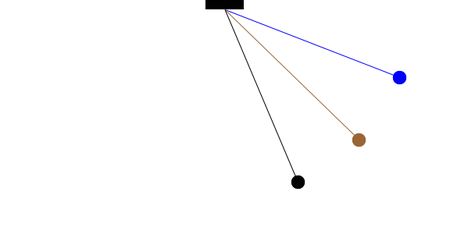
So, as you are about to plant the front foot to swing, the rear leg's real role or function should be to transition. What's the quickest (read: "most powerful") way to transition? It's not "pushing" or "firing" or "exploding" like Coach T loves to demonstrate. It's relaxing or dropping. Dropping off your rear leg is much quicker than pushing off it. The best athletes in the world are often talked about as being able to "fire" muscles quickly compared to their peers. But why wouldn't they also be the best in the world at relaxing their muscles quickly, too?
Here are some examples of athletic motions that I believe demonstrate this concept. See if you can spot it for yourself. Unfortunately, the tool I used to cut the clips, Imgur, converted some to video and some to image format. You can embed images/GIFs on dgcoursereview forums but not video files like MP4, so you'll have to do some clicking and viewing in other windows to investigate them all.
First up, here's Von Miller, one of the greatest speed rushers of all time, with a signature "ghost move" – now you see me, now you don't – on RT Mitchell Schwartz. The rear/back/drive leg is his right. It doesn't push harder to accelerate him into the move/dip. It drops quicker.
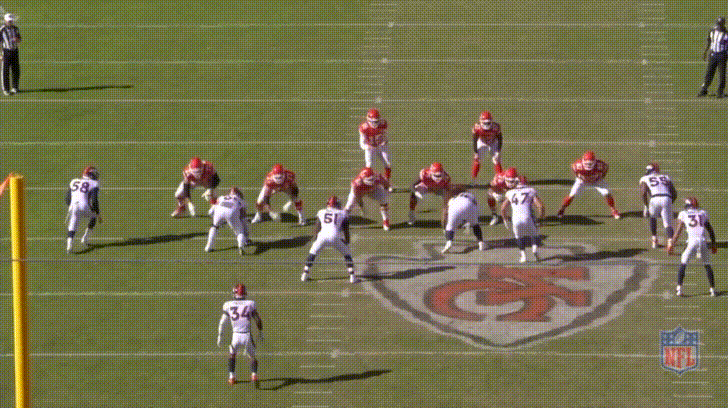
Now, Manu Ginobili with one of those "only Manu" moves – a one handed crossover. Just like Von, watch how Manu's right leg moves to accelerate him into the left plant to "crossover" or change directions.
Imgur video-GIF clip: https://imgur.com/uyJLSnA
Here's Iron Mike loading a haymaker like lightning. He's throwing a right-handed punch, so he's driving/going-up on his left leg. Watch how quickly he drops or goes down on the right leg to load the go up on the other leg. Speed to power.
Imgur video-GIF clip: https://imgur.com/h367y22.
Youtube video link: https://youtu.be/ir01PM2LT-4?t=110
Some Barry Sanders' jukes. Explosive directional changes ("pushes") loaded by quick transitions ("drops") off one leg into the other.
Youtube video link: https://www.youtube.com/watch?v=UD_y4HyltiU
Imgur video-GIF clip: https://imgur.com/VYjWM5E
Imgur video-GIF clip alternate angle: https://imgur.com/ZHCitVa
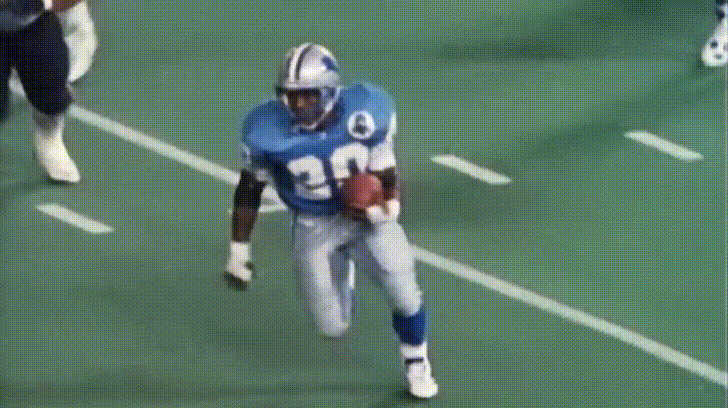
Finally, here's sprinting coach Adarian Barr breaking down a Tyreek Hill agility clip: "These guys, they don't push. If you push, that makes it hard to stop and change directions. Watch what happens with this leg here."
https://www.instagram.com/p/CghRuLtvQ_o/
This forum post is a continuation of discussion in another thread (https://www.dgcoursereview.com/forums/showthread.php?p=3848559#post3848559) motivated by publication of a new Slingshot Disc Golf technique video: "Why you CAN'T Throw Far…What the PROS really do for Big Distance". Part I got swept away charting the contours of a salesman. The focus of Part II is: should you "push" off the back leg into the plant leg to get BIG power in your disc golf swing?
The "front leg" power (bad) vs. "back leg" power (good) distinction Coach T makes in the video is nonsense. We are bipedal beings, and both legs work together codependently to produce power in the disc golf swing just as they do to locomote you through spacetime when you walk or run. One leg picks you up while the other puts you down in a continuous cycle of place trading. It's a bit more complex than that, but this is a good-enough framework for our purposes: in bipedal movement, one leg is the "go up" leg while the other is the "go down" leg. Because of how the legs transition between these roles as you move forward, a not obvious point is: if one leg is doing a poor job or the wrong job, it affects the other leg's ability to do its job, too.
*
At one point in my soccer ball kicking days, I had to seriously work on bringing my off foot (left) up to speed. At a certain level of competition, it's unacceptable to be unable to make an accurate pass more than 30 feet or take a shot on goal with your non-dominant leg. Of course, I blamed my left foot for its ineptitude because it hadn't practiced kicking as many soccer balls as my right foot. It's only now, many years later, that I realize my right leg was equally to blame: the right leg was just as terrible at performing the left leg's role (bracing to kick) as the left leg was at performing the right leg's role (kicking the ball).
Alright, back to the disc golf throw. No, you should not "push" into the plant explosively with the rear leg/toe. That is not the rear leg's role at that point in the swing. The rear leg needs to transition you into the plant. "Pushing", in my conception, means extending/expending energy to lift the body. The rear leg "pushes" the most to bear your weight pretty soon after initial ground contact. If your body does not crumple into the Earth, then the rear leg has successfully performed its job as the "go up" leg during this part of the swing. There's no more pushing in its job description after that. Rather, the rear leg needs to transition or become the "go down" leg so that the front plant leg can best do its duty as the "go up" leg that you use to extend/expend all that wonderful energy into the Frisbee.
Here's the actual secret – pay attention, I said secret! – because the legs' roles at any point in time are dependent upon one another, the amount of "go down" on the rear leg is the amount of "go up" on the front plant leg. More "go up" means more power. A simple analogy for this principle would be a pendulum:

So, as you are about to plant the front foot to swing, the rear leg's real role or function should be to transition. What's the quickest (read: "most powerful") way to transition? It's not "pushing" or "firing" or "exploding" like Coach T loves to demonstrate. It's relaxing or dropping. Dropping off your rear leg is much quicker than pushing off it. The best athletes in the world are often talked about as being able to "fire" muscles quickly compared to their peers. But why wouldn't they also be the best in the world at relaxing their muscles quickly, too?
Here are some examples of athletic motions that I believe demonstrate this concept. See if you can spot it for yourself. Unfortunately, the tool I used to cut the clips, Imgur, converted some to video and some to image format. You can embed images/GIFs on dgcoursereview forums but not video files like MP4, so you'll have to do some clicking and viewing in other windows to investigate them all.
First up, here's Von Miller, one of the greatest speed rushers of all time, with a signature "ghost move" – now you see me, now you don't – on RT Mitchell Schwartz. The rear/back/drive leg is his right. It doesn't push harder to accelerate him into the move/dip. It drops quicker.

Now, Manu Ginobili with one of those "only Manu" moves – a one handed crossover. Just like Von, watch how Manu's right leg moves to accelerate him into the left plant to "crossover" or change directions.
Imgur video-GIF clip: https://imgur.com/uyJLSnA
Here's Iron Mike loading a haymaker like lightning. He's throwing a right-handed punch, so he's driving/going-up on his left leg. Watch how quickly he drops or goes down on the right leg to load the go up on the other leg. Speed to power.
Imgur video-GIF clip: https://imgur.com/h367y22.
Youtube video link: https://youtu.be/ir01PM2LT-4?t=110
Some Barry Sanders' jukes. Explosive directional changes ("pushes") loaded by quick transitions ("drops") off one leg into the other.
Youtube video link: https://www.youtube.com/watch?v=UD_y4HyltiU
Imgur video-GIF clip: https://imgur.com/VYjWM5E
Imgur video-GIF clip alternate angle: https://imgur.com/ZHCitVa

Finally, here's sprinting coach Adarian Barr breaking down a Tyreek Hill agility clip: "These guys, they don't push. If you push, that makes it hard to stop and change directions. Watch what happens with this leg here."
https://www.instagram.com/p/CghRuLtvQ_o/
- Joined
- Aug 16, 2014
- Messages
- 1,680
I was reminded again last night about not pushing off the rear side when re-watching for the millionth time Shawn Clement's "Tilted Super Spiral part 2" where at 5:39 to paraphrase he says "...because we are already against the "front" side, there's no need to push from the "back" side."
https://www.youtube.com/watch?v=2DMwiBkvrkg&t=325s
https://www.youtube.com/watch?v=2DMwiBkvrkg&t=325s
Postscript: Anatomy of an Allen Iverson Crossover
Forgot to highlight: one part of the recipe for Barry Sanders' secret sauce was his ability to transition each leg from "go up" to "go down" & vice versa mid-function. Deceptively explosive, and explosively deceptive.
Allen Iverson was another Greatest-Of-All-Time artist in this medium. Let's take a look at an Iverson masterpiece, the March 12th, 1997 crossover of Michael Jordan. When this game took place, the rookie Iverson was putting the finishing touches on a (successful) NBA ROTY campaign, and the veteran Jordan was readying for a (successful) run at a 4th NBA Championship. In my opinion, this is the greatest cross ever pulled in NBA history. Straight up great-moments-in-sports chills every time for me listening to Iverson recount the tale and you hear that faint shout from Phil Jackson, "Michael!" Brrrr.
Ice cold.
Here's a couple clips cut from this video (unfortunately could not embed them in this post). The best way to view this move granularly is probably to use the < and > keys to go frame by frame in the above Youtube video.
Imgur video-GIF: https://imgur.com/NHOjXyD
Imgur video-GIF slow-motion: https://imgur.com/j906WWa
Below are some screen captures from going frame by frame. For comparison purposes, Iverson's right leg should be considered the rear/back/drive leg. At the start of the crossover move, Iverson's right leg is functioning as the "go up" leg that is pushing/supporting his weight while the left leg picks up and starts to drift.
Iverson right leg "go up":
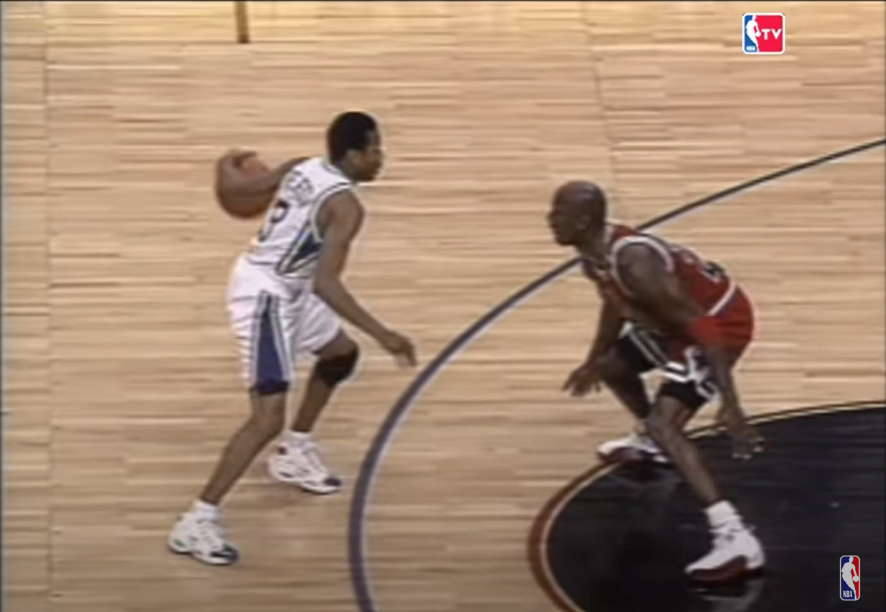
In the next frame, Iverson's right leg begins to drop/transition/relax. Watch Jordan's left heel also pop up off the hardwood, mimicking Iverson's move. Iverson is signaling movement to the right by dropping off his right leg (because this loads the left leg to plant/push back forward/to the right).
Iverson right leg "go down":
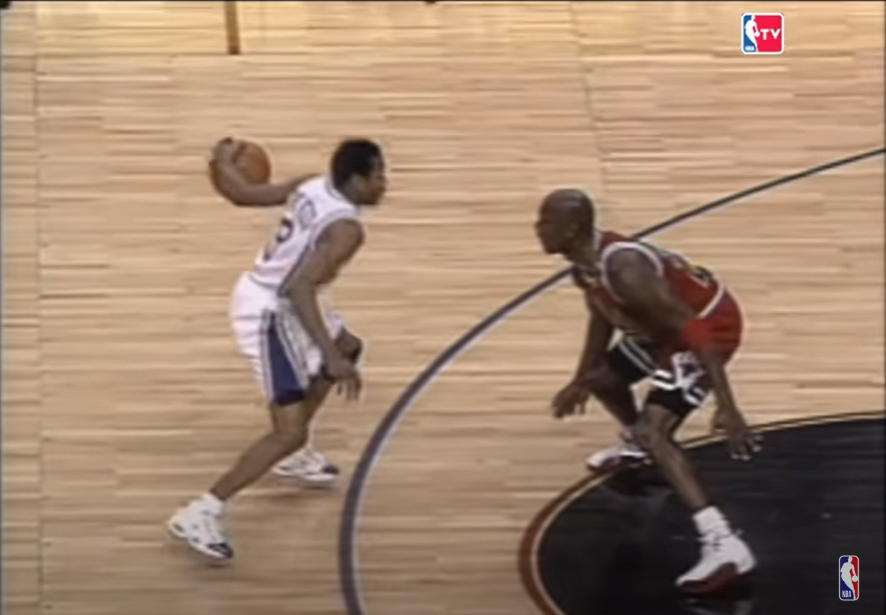
For a moment, Iverson appears airborne with both feet off the floor. Then, he stabs the right leg back down. This signals movement to the left by pushing/extending off his right leg. Compare with Jordan at this point, who's legs are primed to move him the opposite way.
Iverson right leg "go up":

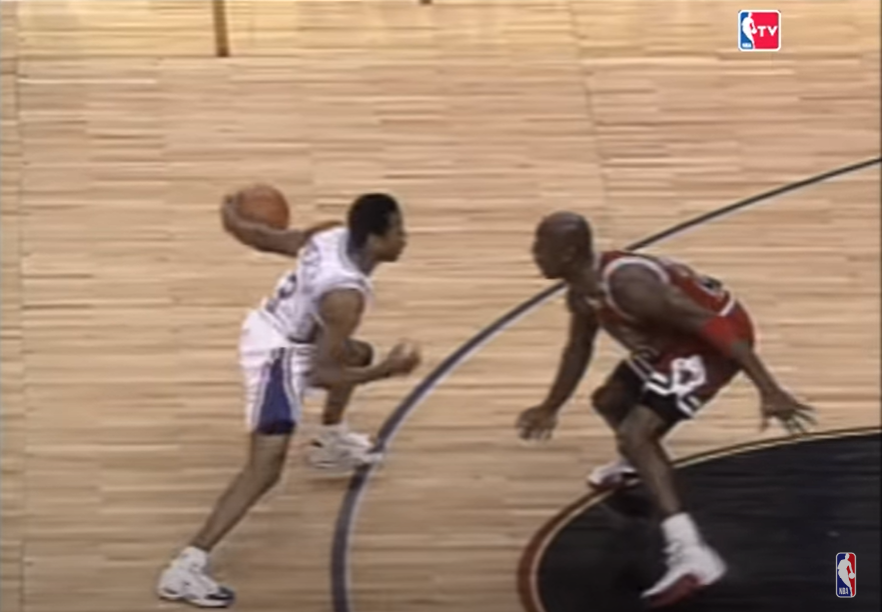
Jordan's left leg starts to stiffen/extend/push in response to Iverson stabbing his right leg back down. Alas, this is the deception. Iverson then relaxes/drops off the right leg like lightning. Iverson's left leg has continued to drift above the court during this whole role reversal charade with his right. After the stab and then the drop on the right, the left leg finally hits the ground into the plant to change directions on the cross.
Iverson right leg "go down":
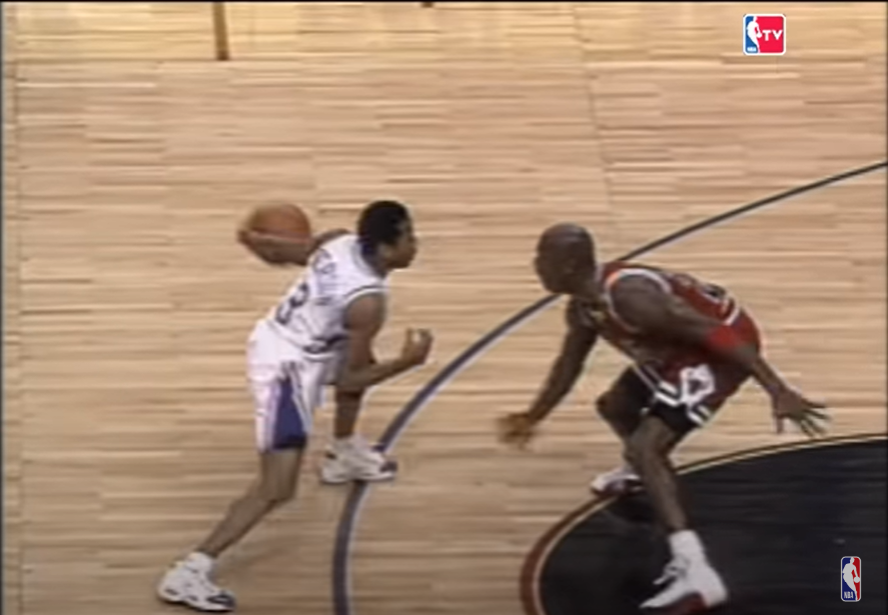
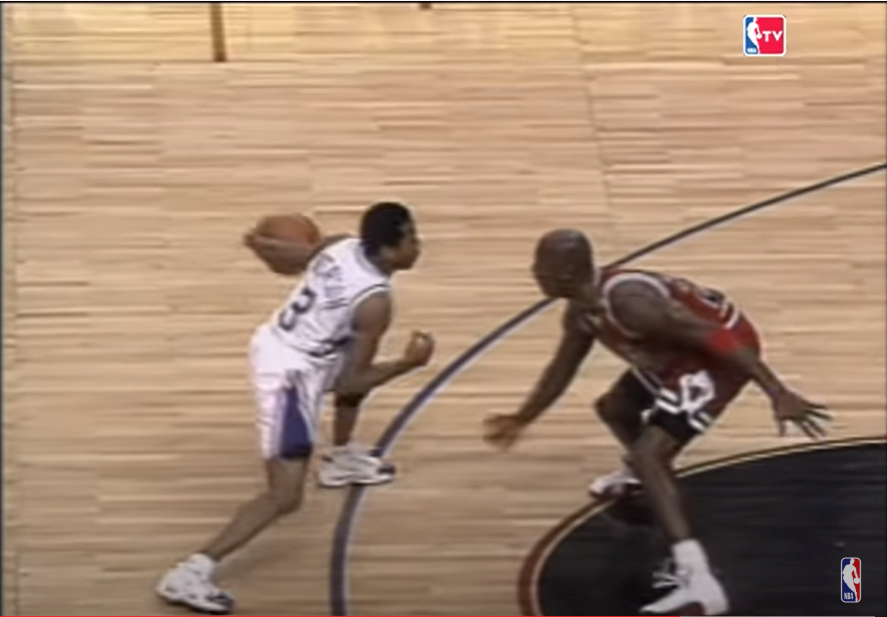
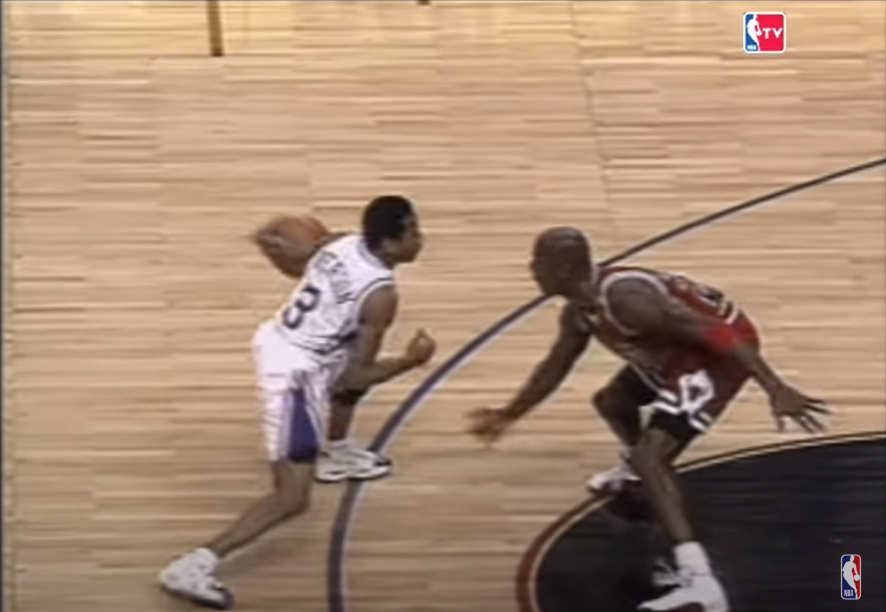
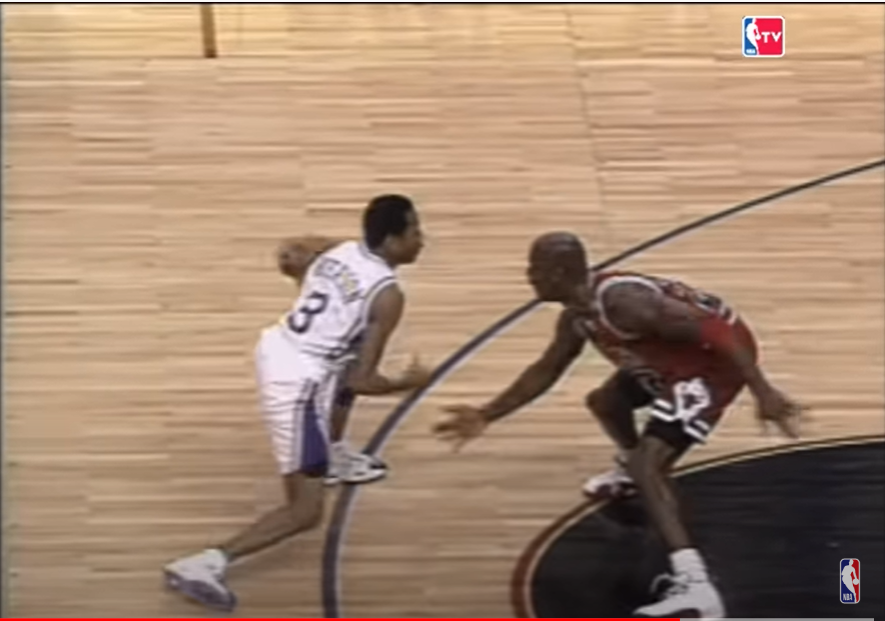
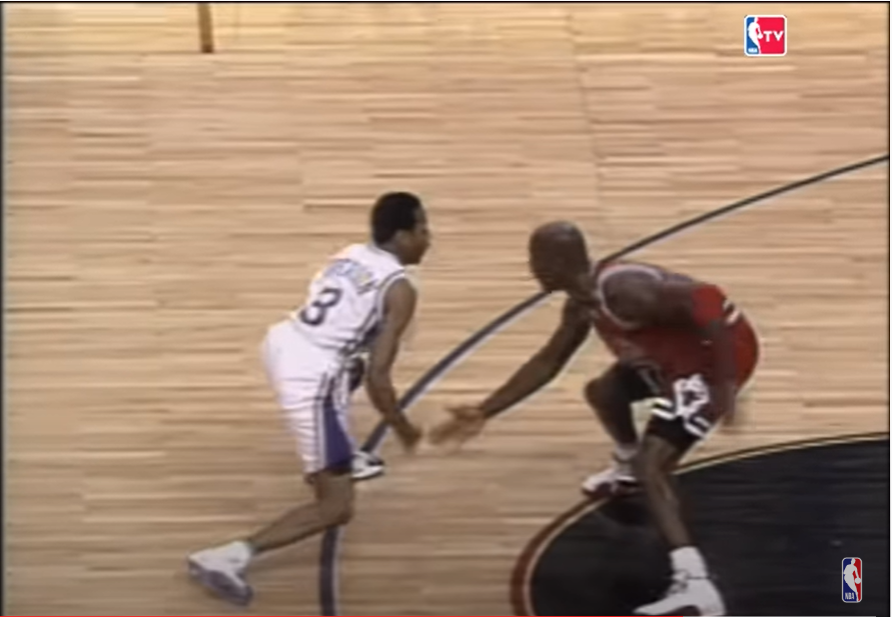
Forgot to highlight: one part of the recipe for Barry Sanders' secret sauce was his ability to transition each leg from "go up" to "go down" & vice versa mid-function. Deceptively explosive, and explosively deceptive.
Allen Iverson was another Greatest-Of-All-Time artist in this medium. Let's take a look at an Iverson masterpiece, the March 12th, 1997 crossover of Michael Jordan. When this game took place, the rookie Iverson was putting the finishing touches on a (successful) NBA ROTY campaign, and the veteran Jordan was readying for a (successful) run at a 4th NBA Championship. In my opinion, this is the greatest cross ever pulled in NBA history. Straight up great-moments-in-sports chills every time for me listening to Iverson recount the tale and you hear that faint shout from Phil Jackson, "Michael!" Brrrr.
Allen Iverson said:When I grabbed the ball, I heard Phil Jackson yell, "Michael!" I gave him a little cross to see, would he bite on it? I let him set his feet, then I stepped it back again.
Ice cold.
Here's a couple clips cut from this video (unfortunately could not embed them in this post). The best way to view this move granularly is probably to use the < and > keys to go frame by frame in the above Youtube video.
Imgur video-GIF: https://imgur.com/NHOjXyD
Imgur video-GIF slow-motion: https://imgur.com/j906WWa
Below are some screen captures from going frame by frame. For comparison purposes, Iverson's right leg should be considered the rear/back/drive leg. At the start of the crossover move, Iverson's right leg is functioning as the "go up" leg that is pushing/supporting his weight while the left leg picks up and starts to drift.
Iverson right leg "go up":

In the next frame, Iverson's right leg begins to drop/transition/relax. Watch Jordan's left heel also pop up off the hardwood, mimicking Iverson's move. Iverson is signaling movement to the right by dropping off his right leg (because this loads the left leg to plant/push back forward/to the right).
Iverson right leg "go down":

For a moment, Iverson appears airborne with both feet off the floor. Then, he stabs the right leg back down. This signals movement to the left by pushing/extending off his right leg. Compare with Jordan at this point, who's legs are primed to move him the opposite way.
Iverson right leg "go up":


Jordan's left leg starts to stiffen/extend/push in response to Iverson stabbing his right leg back down. Alas, this is the deception. Iverson then relaxes/drops off the right leg like lightning. Iverson's left leg has continued to drift above the court during this whole role reversal charade with his right. After the stab and then the drop on the right, the left leg finally hits the ground into the plant to change directions on the cross.
Iverson right leg "go down":





Brychanus
* Ace Member *
<Copious great stuff>
Thank you for writing all of this with such vivid examples! Forgive my quotation marks in the following.
I wanted to add a few words to hang onto your "up leg/down leg" framework and dropping, including what I think I'm learning from what I'm battling through now. Lurkers, don't worry - you can and maybe should learn to do moves without all these words, but I find it interesting.
An attempt to reconcile some language
This is an attempt to yoke some of the language we throw around here to what you are saying about dynamic motion and the similarity in mechanics but opposition in flow in the drive and plant leg.
Sometimes we talk about a leg "resisting collapse" when it plants - this is often said about the plant leg but is true of the drive leg & what SW22 likes to show with a back-and-forth can crush under both heels.
When we talked about Zelezny or Tyson or Shiying's slightly laggier action and the other examples you share here, I just wanted to remind us that there is still a "plant" in the drive leg. I think that is consistent with when the leg starts to "resist collapse", and becomes as briefly as possible the "up leg" involving the "push" you defined here. The best move from there is the one which facilitates the drive leg maintaining leverage until it should become the "down leg", which is the same as ending the "push" to drop into the plant to swing as quickly as possible. The plant leg, at that moment, is also only in the "up leg" phase long enough ("pushing"/"extending"/"resisting collapsed while compressed") to facilitate the swing and/or to remain balanced upright on it into the finish.
I also know the word "extension" was problematic earlier - I don't think the extension you're talking about should be confusing - in Iverson's move, his "stab" before the final crossover (involving anatomical extensions) is part of how he recontacts the ground to start his brief "up leg" on that side, but he then immediately continues the drop into to the left foot by turning the right leg into a "down leg" again. The anatomical extension of his right leg from there is more like the after image of his leg releasing leverage & tension into the drop.
Other thoughts from learning a crossover
Hopefully I don't bungle the language here, let's see:
All of the examples were helpful, and the Iverson crossover breakdown really helped me think more about this action and all the weird dynamics in the body and against gravity going on. I did my best to learn my ungainly amateur version of the move, and thought about how it related to what you wrote. I realized that I had learned a similar juke in boxing a long time ago so I imagined that. I found it easier to do in a right-handed boxing stance but then started to get it to work on the left.
Anyway, I think the stabbing back with the right leg while he's in an initial "go down" phase off that same leg is occurring as part of that "free falling" phase mentioned around here sometimes. I couldn't figure out how to do it immediately, but then I realized I could get the stab in transition in the "freefall" moment as part of the pendulum rock, then land on the left leg (now initiating the left leg's "up leg" phase) and drop ("left leg down leg") much more quickly into the right leg (initiating "right leg up leg"). And I noticed that during the crossover move, the left leg counterbalances the right leg during the move in order to achieve the stab as the body is swinging over the legs - notice that the foot swings back toward the right leg very briefly before swinging back to his left to plant. My left foot did the same thing because it was part of the overall rock/pendulum action.
Same feel as the new leverage I'm starting to get out of the Door Frame Drills if I don't start too extended, and yes, it changes what happens on the plant side since they're intimately connected.
Individual differences anecdote - my leg's aren't like Wysocki's, nor are most people's. SW22 reminds people that it's ok for the heel to come down in a drive leg move. I do think it's likely that when you see someone like Wysocki vault over their drive leg move or Simon more horizontally they're enjoying a high level of leverage and athleticism, and I can't imagine it doesn't benefit their acceleration greatly. But if you can't pull off a ninja-like elevated heel, you can still seek that powerful leverage off the rear foot like a pitcher on the rubber-heel more or all the way down with pressure flowing. I'm getting a lot of mileage out of Door frame trying to solve it.
Words aside, this was legitimately helpful, thanks
Sheep
Sir, This is a Wendy's
- Joined
- Jul 27, 2017
- Messages
- 1,370
This is where I've been lost on this topic with the drive leg.
And I think there is some other things we might be missing after reviewing Brodie's form as well. Because his drive leg starts out really really bad based on fundamentals, and then turns into an absolute powerhouse at just the right time to drive his brace.
So, after catching up reading in this thread, I think its important how we define driving the brace with the off leg. And also point out that there is more than one way to power into the brace.
Now for the example of slingshot.
I ... yeah, lets just take the garbage can, throw it in a garbage can, throw it in the dumpster and just set it on fire. Cause... It's funny, but. it's just nowhere close to correct or anything but amusement and stuff to use old gasoline on that isn't good enough to run the lawnmower anymore.
With some more recent thinking on the off leg driving into the brace, I have concluded there are 2 ways to define getting power into the brace. This came from Brychanus when he was talking about Drift, and that word clicked something for me. And I think it might be important in the overall point of this whole discussion.
First, The old(er) school way of bracing is Inertia bracing. Where a HUGE run up which kind of puts away good footwork in favor of using our momentum to drive the brace.
And then we have a more newer school form of this which is pushing into the brace with the off leg. This is what Drew does, and also what he teaches in his clinics. Not necessarily a dump on Socradeez, because what he's saying is enlightening, but also having had drew gibson here for a distance clinic, he absolutely teaches driving into the brace with your off leg as what he does to generate power.
Which also got me into a bunch of weird thinking. So, if you can power into the brace with your offlegg. You can mix inertia with the push, but if you cannot do the offleg push, you cannot mix the 2 together. which ... was different to think about.
But what we want to do is get that brace to generate power, and I think part of this thread comes into getting that energy transferred and pushed into the brace in a better way. And maybe this has become misunderstood because of some weird form stuff?
This isnt' fully fleshed out thoughts, and something i can demonstrate far better in video/person though. but I think we are definitly missing a few details on the off leg based on some of these guys who are using some really bad off leg mechanics but getting good results.
And I think there is some other things we might be missing after reviewing Brodie's form as well. Because his drive leg starts out really really bad based on fundamentals, and then turns into an absolute powerhouse at just the right time to drive his brace.
So, after catching up reading in this thread, I think its important how we define driving the brace with the off leg. And also point out that there is more than one way to power into the brace.
Now for the example of slingshot.
I ... yeah, lets just take the garbage can, throw it in a garbage can, throw it in the dumpster and just set it on fire. Cause... It's funny, but. it's just nowhere close to correct or anything but amusement and stuff to use old gasoline on that isn't good enough to run the lawnmower anymore.
With some more recent thinking on the off leg driving into the brace, I have concluded there are 2 ways to define getting power into the brace. This came from Brychanus when he was talking about Drift, and that word clicked something for me. And I think it might be important in the overall point of this whole discussion.
First, The old(er) school way of bracing is Inertia bracing. Where a HUGE run up which kind of puts away good footwork in favor of using our momentum to drive the brace.
And then we have a more newer school form of this which is pushing into the brace with the off leg. This is what Drew does, and also what he teaches in his clinics. Not necessarily a dump on Socradeez, because what he's saying is enlightening, but also having had drew gibson here for a distance clinic, he absolutely teaches driving into the brace with your off leg as what he does to generate power.
Which also got me into a bunch of weird thinking. So, if you can power into the brace with your offlegg. You can mix inertia with the push, but if you cannot do the offleg push, you cannot mix the 2 together. which ... was different to think about.
But what we want to do is get that brace to generate power, and I think part of this thread comes into getting that energy transferred and pushed into the brace in a better way. And maybe this has become misunderstood because of some weird form stuff?
This isnt' fully fleshed out thoughts, and something i can demonstrate far better in video/person though. but I think we are definitly missing a few details on the off leg based on some of these guys who are using some really bad off leg mechanics but getting good results.
Brychanus
* Ace Member *
This is where I've been lost on this topic with the drive leg.
And I think there is some other things we might be missing after reviewing Brodie's form as well. Because his drive leg starts out really really bad based on fundamentals, and then turns into an absolute powerhouse at just the right time to drive his brace.
What do you see?
There's a little bit of extra drive leg motion and some unusual extension before the x-step (maybe compensating for balky knees). Once he lands in the x-step he's getting pretty quick into the plant. However, it looks like he lands a little uncomfortably staggered closed with his body a bit in the way when he swings.
Sheep
Sir, This is a Wendy's
- Joined
- Jul 27, 2017
- Messages
- 1,370
What do you see?
There's a little bit of extra drive leg motion and some unusual extension before the x-step (maybe compensating for balky knees). Once he lands in the x-step he's getting pretty quick into the plant. However, it looks like he lands a little uncomfortably staggered closed with his body a bit in the way when he swings.
That angle was terrible.
Brodie has a really rear open step on his x-step, sometimes obnoxiously wide open, but right at the right important time, it suddenly turns and drives hard into the brace.
I'd have to find the video again, and.. I don't even remember that much from any of it.
It was kind of interesting overall to look at when I was checking it out.
Similar threads
- Replies
- 100
- Views
- 5K
- Replies
- 4
- Views
- 848